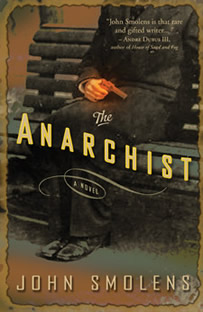
The back cover of The Anarchist by John Smolens (English) features the following at the top in bold print: “Terrorism and unrest in a world on the verge of madness: This is America, 1901.” Some might argue that it could also describe America, 2010. While Smolens’ sixth novel weaves a suspenseful, character-driven account of historical facts surrounding the assassination of President William McKinley, he sees parallels between the populist discontent that fueled the anarchist movement at the turn of the 20th century and the modern brand of terrorism responsible for 9/11 and other attacks.
“Both represent the most extreme points of view, not to mention a willingness to give their lives for the cause and resort to blatant violence to threaten the existing order in the United States and Europe,” said Smolens. “Anarchists opposed any form of cultural restraint on human beings—from government to religion. They didn’t believe in laws. They appealed to the oppressed working class and believed that if you eliminated the rulers, individuals would be liberated. It was this extreme minority for which Leon Czolgosz served as a martyr.”
A Michigan native, Czolgosz stalked the president during an official visit to the Pan-American Exposition in Buffalo, N. Y. He waited in a public greeting line to shake hands with McKinley—evidence of relatively lax security in those days—with a handkerchief concealing a revolver in his right hand and held across his chest as if it were a sling. Czolgosz fired two shots upon meeting the president. When McKinley died, Theodore Roosevelt was sworn into office while rioting mobs stormed police headquarters in an attempt to lynch the assassin.
“The book covers the events before, during and after the shooting from four points of view,” Smolens said. “Two are real: Czolgosz and Dr. Presley Rixey, the president’s personal physician. I included Rixey’s perspective because it took McKinley a week to die, so I could portray what was happening to and around the president during that time. The other two are fictional characters: Pinkerton detective Jake Norris and his undercover agent, Moses Hyde. I developed them based on material I read about the Pinkertons, who provided security for the president and recruited spies for workers’ unions and anarchist groups.”
“I’ve always wanted to learn more about life at the turn of the 20th century, so it was fascinating to research the first significant event of this era and the people involved,” Smolens added. “Leon Czolgosz is the centerpiece, but so little was known about him. That appealed to me as a fiction writer. His mother’s death during childbirth when he was 10 had an enduring impact. Czolgosz was a loner who absorbed anarchist propaganda and spent months before the assassination hopping trains throughout the Midwest. He also used elixirs, which might explain why others described him as being in a dazed, dream-like state. These small glimpses took on added importance in trying to flesh out his character.”
The Anarchist was published by Three Rivers Press and is available as a paperback or e-book. For more information, visit John Smolens. |



 Smolens spent five years researching and writing The Anarchist, visiting libraries in Chicago and Buffalo. He said newspapers conveyed the grief, fear and anger that gripped the nation after the shooting and also the broader social context of the period—from how people dressed to how much things cost. Photographs reflected that Buffalo, like many American cities at the time, was experiencing rampant crime and prostitution and a large influx of immigrants desperate for work. Smolens also studied the Erie Canal, which factors prominently in the locale of the book. Many scenes are based on real events and the dialogue during Czolgosz’s trial was gleaned directly from court transcripts.
Smolens spent five years researching and writing The Anarchist, visiting libraries in Chicago and Buffalo. He said newspapers conveyed the grief, fear and anger that gripped the nation after the shooting and also the broader social context of the period—from how people dressed to how much things cost. Photographs reflected that Buffalo, like many American cities at the time, was experiencing rampant crime and prostitution and a large influx of immigrants desperate for work. Smolens also studied the Erie Canal, which factors prominently in the locale of the book. Many scenes are based on real events and the dialogue during Czolgosz’s trial was gleaned directly from court transcripts.